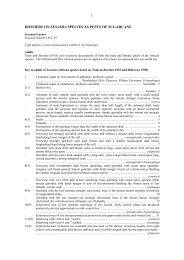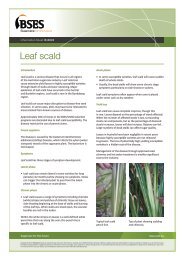Create successful ePaper yourself
Turn your PDF publications into a flip-book with our unique Google optimized e-Paper software.
QCrOps / BArry sALTer<br />
evALuATiON Of vArieTies<br />
fOr A CONTrOLLeD-TrAffiC<br />
fArMiNG sysTeM<br />
AN srDC fuNDeD prOjeCT TiTLeD ‘evALuATiON Of GeNOTypes fOr A<br />
CONTrOLLeD-TrAffiC fArMiNG sysTeM’ is CurreNTLy uNDerWAy.<br />
Project leader Dr Barry Salter, research<br />
agronomist based at <strong>BSES</strong> Mackay<br />
discusses progress to date.<br />
Some years ago the Sugar Yield Decline<br />
Joint Venture (SYDJV) recommended<br />
that sugarcane be grown using controlledtraffic,<br />
following its findings that, when<br />
coupled with legume fallow crops and<br />
reduced tillage, a controlled-traffic<br />
system brought significant improvements<br />
to soil health. The system has been<br />
widely adopted, and row spacings<br />
between 1.8 and 2.0 m are now<br />
common throughout the industry.<br />
Now an SRDC-funded project* is underway<br />
to determine whether varieties that<br />
ere selected on 1.5 m single row<br />
configurations are suitable for wider<br />
row configurations (both single and<br />
dual). Experiments in progress are also<br />
determining what changes are needed<br />
TABlE 1 | Trial information.<br />
to the selection system, to ensure that<br />
varieties with good performance on<br />
wide-row configurations are released<br />
in the future.<br />
TriALs<br />
Trials comprising four current varieties<br />
and three row configurations were<br />
established at Bundaberg, Mackay, Ingham<br />
and Meringa. In the Burdekin, six current<br />
varieties and two row configurations were<br />
used. Trial information is summarised in<br />
Table 1.<br />
At the time trials were planted, sugarcane<br />
smut was found in Queensland, therefore<br />
smut-resistant varieties were selected<br />
where possible. In the Burdekin,<br />
researchers included Q117 and Tellus A ,<br />
which were known to have different growth<br />
patterns. Q117 tends to produce a small<br />
number of large stalks, while Tellus A is<br />
characterised by slow growth early in<br />
crop development. Both of these growth<br />
habits may be an advantage in dual row<br />
systems, as plants may suffer less from<br />
lodging than fast-growing varieties with a<br />
large number of thin stalks. All the trials<br />
except Mackay were sampled over the<br />
plant and 1 st ratoon crops.<br />
r esuLTs<br />
The results from Bundaberg (Table 2)<br />
showed that there was no difference in<br />
yield – tonnes of cane per hectare (TCH)<br />
and tonnes of sugar per hectare (TSH) –<br />
among row configurations. Differences<br />
were found among varieties – Q232 A and<br />
Q208 A performed best. No statistically<br />
significant variety-by-row spacing<br />
interaction was found. All varieties reacted<br />
to the different row configurations in a<br />
similar manner. When a variety performed<br />
well it did so on all row configurations.<br />
Trials Genotype Row configuration Planter Land preparation Planting date<br />
Bundaberg<br />
Mackay<br />
Burdekin<br />
Ingham<br />
Meringa<br />
Q151<br />
Q190 A<br />
Q208 A<br />
Q232 A<br />
Q190 A<br />
Q200 A<br />
Q208 A<br />
Q209 A<br />
Q117<br />
Q171 A<br />
Q200 A<br />
Q208 A<br />
KQ228 A<br />
Tellus A<br />
Q135<br />
Q174 A<br />
Q183 A<br />
Q200 A<br />
Q186 A<br />
Q200 A<br />
Q201 A<br />
Q220 A<br />
1.5 m single<br />
1.8 m single<br />
1.8 m dual (500 mm)<br />
1.5 m single<br />
1.8 m single<br />
1.8 m dual (500 mm)<br />
1.85 m single<br />
1.85 m dual (450 mm)<br />
1.63 m single<br />
1.83 m single<br />
1.83 m dual (450 mm)<br />
1.52 m single<br />
1.85 m single<br />
1.85 m dual (500 mm)<br />
DDOP – DOuBlE-DISC OPENER PlANTER. ROW CONfIGuRATION – VAluES IN<br />
BRACKETS REPRESENT DISTANCE BETWEEN DuAl ROWS<br />
DDOP<br />
DDOP<br />
DDOP<br />
DDOP<br />
DDOP<br />
DDOP<br />
DDOP<br />
DDOP<br />
Mouldboard<br />
DDOP<br />
DDOP<br />
Mouldboard<br />
Mouldboard<br />
Mouldboard<br />
Planted flat + hill-up 13–17 September<br />
2007<br />
Pre-formed beds 13–15 September<br />
2006<br />
Pre-formed beds 9–4 May 2007<br />
Planted flat + hill-up 1–9 August 2006<br />
Planted flat + hill up 15–24 August 2006<br />
p 3 i s s u e 2 5




